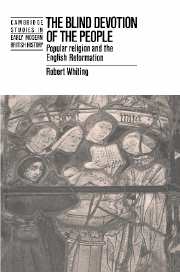Book contents
- Frontmatter
- Contents
- List of illustrations
- Preface
- Note
- 1 Introduction
- 2 Survey
- PART ONE ASSESSMENT
- 3 Dependent activities: sacraments, ceremonies and intercessions
- 4 Independent activities: prayers, images and cult objects
- 5 Inclusive institutions: parish churches, chapels and guilds
- 6 Exclusive institutions: papacy, religious orders and secular clergy
- 7 Summation of Part One
- PART TWO EXPLANATION
- Appendix 1 Maps
- Appendix 2 Graphs
- Bibliography and abbreviations
- Index
4 - Independent activities: prayers, images and cult objects
Published online by Cambridge University Press: 11 December 2009
- Frontmatter
- Contents
- List of illustrations
- Preface
- Note
- 1 Introduction
- 2 Survey
- PART ONE ASSESSMENT
- 3 Dependent activities: sacraments, ceremonies and intercessions
- 4 Independent activities: prayers, images and cult objects
- 5 Inclusive institutions: parish churches, chapels and guilds
- 6 Exclusive institutions: papacy, religious orders and secular clergy
- 7 Summation of Part One
- PART TWO EXPLANATION
- Appendix 1 Maps
- Appendix 2 Graphs
- Bibliography and abbreviations
- Index
Summary
The dependent activities of the pre-Reformation layman remained reliant upon the clergy and its ministrations. His independent activities, in contrast, were essentially autonomous. A variety of religious practices enabled him in effect to bypass the priests, monks and friars, and thus to attain contact of a more direct and personal nature with the heavenly powers.
The most fundamental of these practices was prayer, which he might perform as an individual or in a group. The inmates of the almshouse founded by John Trotte at Cullompton in 1523, for example, were specifically required to pray for his and certain other souls. Joan Tackle, at Honiton in 1528, bequeathed 4d to each householder in the town to pray for her, and John Greenway, arranging his burial at Tiverton in 1529, ensured similar prayers for his soul by providing the local poor with a dinner and a dole of £20. Prayers on behalf of their deceased ‘brothers’ and ‘sisters’ were also recited by the lay members of religious guilds, such as the guild of the Holy Trinity at Helston in 1517. Prayers of these types might be facilitated by fasting, particularly on the specified fast days, and by the employment of rosaries, through which God and Our Lady might be formally invoked. Amongst the offerings to the rood at Crediton in 1524 was ‘a pair of beads, all silver, with 53 Ave Marias and 6 Pater Nosters’, and such rosaries were frequently depicted on early-Tudor memorials, like that of Joan Easton at Morchard Bishop.
- Type
- Chapter
- Information
- The Blind Devotion of the PeoplePopular Religion and the English Reformation, pp. 48 - 82Publisher: Cambridge University PressPrint publication year: 1989



